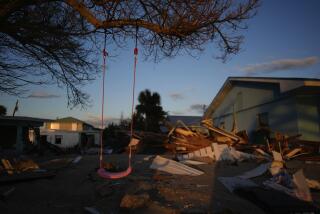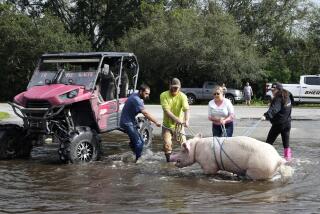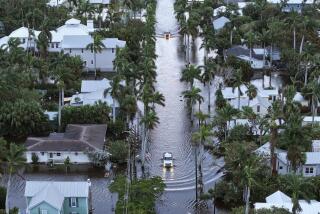Hurricane Frances Slows, Crawls Toward Florida
- Share via
VERO BEACH, Fla. — The outer bands of Hurricane Frances, a haggard but colossal storm, began lashing eastern Florida’s deserted beach towns Friday night. The full force of the storm is expected to strike today, bringing furious winds and more than a foot of rain to a beleaguered state that is still digging out from the last hurricane.
The strength and track of the last storm, Hurricane Charley, caught hundreds of thousands of Floridians by surprise three weeks ago. Frances is three times Charley’s size, and residents took no chances this time.
More than 2.5 million people cleared out of the path of the storm, causing a massive bottleneck Friday in northern Florida and southern Georgia. The evacuation bordered on chaos in some areas, with gas shortages and traffic jams so bad that parents were seen holding their toddlers out car windows to urinate on the road. Hotels were booked as far away as Atlanta, more than 500 miles from the likely strike zone here.
“We had ‘Hurricane 101’ three weeks ago,” said Dale Brill, a vice president of Visit Florida, the state’s tourism marketing agency. “If my mother tells me not to touch the stove and I do it anyway, the second time I’m going to pay attention.”
Frances settled over the Bahamas on Friday, pounding the islands with as much as 20 inches of rain. In Nassau, the hurricane knocked out power, shattered windows, dislodged roofs and uprooted trees. Heavy surf destroyed boats. Frances claimed her first victim -- a teenager electrocuted while refueling his family’s generator.
Though the storm slowed, a hurricane warning remained in effect along Florida’s populous eastern coast. By 8 p.m., Frances’ sustained winds had died down from about 145 mph to about 105 mph, making it a Category 2 storm on the five-step intensity scale. But Frances is still a powerful storm, and state officials expect it to strengthen as it passes today over the 88-degree waters of the Gulf Stream, which hugs the coast of Florida.
The enormous weather system, plodding northwest at 4 mph, could cover the width of Florida and linger over the state for more than 24 hours -- and at least two high-tide cycles.
It could produce as much as 20 inches of rain in some places and a coastal storm surge that could be five feet higher than normal levels. Though people typically fixate on the wind that batters the coast during a hurricane, the rain that follows could be far more destructive this time, officials said.
Don Daniels, emergency management coordinator for St. Lucie County, Fla., north of West Palm Beach and home to 200,000 people, said a heavy afternoon downpour is often enough to flood the county.
“We are a swamp to begin with,” Daniels said. “If we get 10 to 15 inches of rain, a lot of areas of Florida are going to be under water.”
The storm is expected to make landfall this afternoon or evening near Vero Beach, best known in Southern California as the spring training home of the Los Angeles Dodgers.
The rains could decimate crops. Large agricultural areas -- including the bulk of the state’s citrus industry, 20% of which was destroyed by Charley -- lie not far from the coast here.
“The wind would just wipe out the crop, but the rain could loosen the ground and then the wind would come along and blow over the trees,” said Julius Pflum, who runs a small citrus and star fruit orchard outside Palm City, south of Vero Beach near the city of Stuart. “Then I lose everything.”
North and west of Pflum’s orchard and the rest of the strike zone, hundreds of thousands of people attempted to flee the storm. Hotels were booked throughout northern Florida and southern Georgia. Many shelters were full and were turning people away. Refugees without a place to stay were sleeping in hotel lobbies, in parking lots, on church pews and even at campsites.
“This is the largest mass exodus I have ever seen,” said Myrna Ballard, president of the Chamber of Commerce in Valdosta, Ga., where all 3,500 hotel rooms were booked.
At gas stations that still had fuel, some lines were more than three miles long. Cars that had run out of gas were lined up on the shoulder of Interstate 75 in southern Georgia, their exhausted and exasperated drivers still inside. Some people reported running into stores to buy supplies, only to find that the gas had been siphoned from their cars while they were inside.
“It’s very intense, the sheer number of people leaving Florida,” said Larry Hanson, city manager of Valdosta, Ga. “We’re seeing people arrive here ... with a sense of desperation. Even the emergency lanes are filled with people just sitting there.”
Those who secured a hotel room were relieved to be out of Frances’ path.
Lynda Akins, 57, of Haines City, Fla., pulled into a Best Western in Morrow, Ga., with peeling paint and a view of a waffle restaurant, and couldn’t have been happier. Akins survived Charley by huddling in a linen closet, and heard the nails being plucked from her roof. She said she took three antianxiety pills while she was driving to Georgia.
“I’ll sleep like a baby,” she said. “I just don’t want to get back in that linen closet.”
Liz Rubinger, 21, said she and her fiance encountered numerous obstacles after they were evacuated early Thursday from their home in Hollywood, south of Fort Lauderdale.
First, the local shelters would not accept the couple with their pets -- a dog, two cats and a ferret. They started driving with the animals, but it took them 16 hours to get to Ocala, northwest of Orlando. The drive normally takes five hours. Still unable to find a hotel room, they called hotels.com to find a vacancy. The nearest one, they were told, was in Tennessee, which is where they were headed.
“We passed one sign that said the next fuel station was eight miles,” Rubinger said. “It took us nearly three hours to make it that far.”
Ocala, a slow-paced city peppered with retirement communities and horse farms, has been transformed into a way station for people fleeing Frances, largely because it sits alongside Interstate 75. At the Country Inn and Suites, which had been booked solid for days, Matthew Klosty and buddy Don Meyers, South Florida retirees, snagged one of the last rooms. The friends live on island communities near Jensen Beach, and were evacuated Thursday.
“I guess this is far enough,” Klosty said, eyeing the sky outside in search of storm clouds. “It better be. There’s nowhere else to go.”
Others, spooked by reports of crowds heading north, decided to stay put.
They included a group of residents at a mobile home park in Hobe Sound in Martin County. Friday, they shelled peanuts and played cribbage inside the park’s community center, where two signs were hung. The first read: “Bingo on Thursday.” The second read: “This building is not designed as a hurricane center.”
“We don’t have to wait three hours for the bathroom here, said Valarie Jaynes, 52.
Maralee Kaler, 60, was asked why she lives in a trailer home in hurricane country.
“All our lives my husband and I struggled to pay the bills,” she said. “When the time came, we could have played it safe and stayed in Maine freezing our tails off. We decided to take a chance. We couldn’t afford a home down here -- no ordinary-income person could. So we got a mobile home.”
And if it’s blown away this weekend?
“We had nearly three wonderful years,” she said. “When it’s over we’ll go out, we’ll cry our tears and then we’ll go on.”
Dahlburg reported from Vero Beach, Glionna from Ocala and Barry from Morrow, Ga. Times staff writers David Colker in Martin County, Chris Gaither in Palm Beach County, Carol J. Williams in Miami, Scott Gold in Houston, Jason Reid in Los Angeles and news researcher Lianne Hart in Houston contributed to this report.
More to Read
Sign up for Essential California
The most important California stories and recommendations in your inbox every morning.
You may occasionally receive promotional content from the Los Angeles Times.










